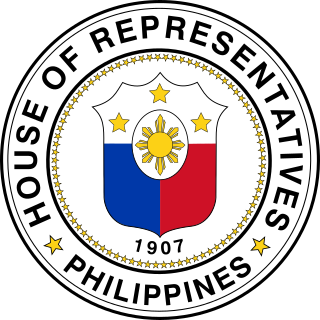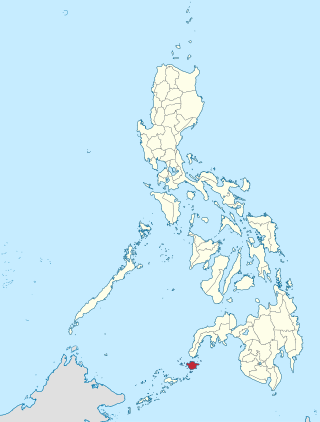
In the Philippines, regions are administrative divisions that primarily serve to coordinate planning and organize national government services across multiple local government units (LGUs). Most national government offices provide services through their regional branches instead of having direct provincial or city offices. Regional offices are usually but not necessarily located in the city designated as the regional center.

The House of Representatives of the Philippines is the lower house of Congress, the bicameral legislature of the Philippines, with the Senate of the Philippines as the upper house. The lower house is commonly referred to as Congress, although the term collectively refers to both houses.
Elections in the Philippines are of several types. The president, vice-president, and the senators are elected for a six-year term, while the members of the House of Representatives, governors, vice-governors, members of the Sangguniang Panlalawigan, mayors, vice-mayors, members of the Sangguniang Panlungsod/members of the Sangguniang Bayan, barangay officials, and the members of the Sangguniang Kabataan are elected to serve for a three-year term.
The Philippines is divided into four levels of administrative divisions, with the lower three being defined in the Local Government Code of 1991 as local government units (LGUs). They are, from the highest to the lowest:
- Regions are mostly used to organize national services. Of the 17 regions, only one—the Bangsamoro Autonomous Region in Muslim Mindanao—has an elected government to which the central government has devolved competencies.
- Provinces, independent cities, and one independent municipality (Pateros)
- Component cities and municipalities within a province
- Barangays within a city or municipality
The legislative districts of Zamboanga City are the representations of the highly urbanized city of Zamboanga in the various national legislatures of the Philippines. The city is currently represented in the lower house of the Congress of the Philippines through its first and second congressional districts.
The legislative districts of Basilan are the representations of the province of Basilan in the various national legislatures of the Philippines. The province is currently represented in the lower house of the Congress of the Philippines through its lone congressional district.
The legislative districts of Zamboanga del Norte are the representations of the province of Zamboanga del Norte in the various national legislatures of the Philippines. The province is currently represented in the lower house of the Congress of the Philippines through its first, second and third congressional districts.
The legislative districts of Zamboanga del Sur are the representations of the province of Zamboanga del Sur in the various national legislatures of the Philippines. The province is currently represented in the lower house of the Congress of the Philippines through its first and second congressional districts.
The legislative districts of Sulu are the representations of the province of Sulu in the various national legislatures of the Philippines. The province is currently represented in the lower house of the Congress of the Philippines through its first and second congressional districts.
The legislative districts of Maguindanao were the representations of the province of Maguindanao and the independent component city of Cotabato in the various national legislatures of the Philippines. The province and the city were represented in the lower house of the Congress of the Philippines through their first and second congressional districts from 1987–2022.
The legislative districts of Cotabato are the representations of the province of Cotabato in the various national legislatures of the Philippines. The province is currently represented in the lower house of the Congress of the Philippines through its first, second, and third congressional districts.
Electoral districts go by different names depending on the country and the office being elected.
Local elections were held in the Philippines on May 13, 2013, the same day and on the same ballot as national elections. Elected were governors, mayors and council members of Philippine provinces, Philippine cities and Philippine municipalities. Separate elections for barangay officials were held on October.
The Zamboanga City Council is Zamboanga City's Sangguniang Panlungsod or local legislature.

Local elections in the Philippines were held on May 9, 2016. This was conducted together with the 2016 general election for national positions. All elected positions above the barangay (village) level were disputed.
Ulbert Ulama “Bob” Tugung was a Filipino teacher, newsman, and politician. He served as Chairman of the Lupong Tagapagpaganap ng Pook (LTP) of Autonomous Region IX in Mindanao from 1979 until his assassination in 1986.

The Zamboanga del Sur Provincial Board is the Sangguniang Panlalawigan of the Philippine province of Zamboanga del Sur.

The Zamboanga Sibugay Provincial Board is the Sangguniang Panlalawigan of the Philippine province of Zamboanga Sibugay.
The Dipolog City Council is Dipolog's Sangguniang Panlungsod or legislative body. The council has thirteen (13) members which is composed of ten (10) councilors, one (1) ex officio member elected from the ranks of barangay (neighborhood) chairmen, one (1) ex officio member elected from the ranks of Sangguniang Kabataan chairmen and one (1) presiding officer. The city's vice-mayor is the council's presiding officer, who is elected citywide.

Basilan's at-large congressional district refers to the lone congressional district of the Philippines in the province of Basilan. The province has been represented in the country's national legislatures since 1984. It first elected a representative provincewide at-large during the 1984 Philippine parliamentary election following the restoration of provincial and city district representation in the Batasang Pambansa where Basilan had previously been included in the regionwide representation of Western Mindanao for the interim parliament. The province, created by the 1973 separation from Zamboanga del Sur of the entire island with its two municipal districts and the municipality of Isabela outside its poblacion which was earlier organized as the City of Basilan separated from Zamboanga City, was formerly represented as part of Zamboanga del Sur's, Zamboanga's and Department of Mindanao and Sulu's at-large representations in earlier legislatures. Since the 1987 restoration of Congress following the ratification of a new constitution, Basilan has been entitled to one member in the House of Representatives. It is currently represented in the 19th Congress by Mujiv Hataman of the Basilan Unity Party (BUP).







